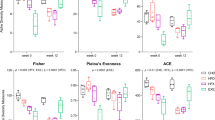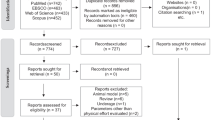Abstract
High-intensity interval training (HIT) has been proposed to exert multiple beneficial effects and positively affect gut microbiota, while how HIT would affect gut microbiota profiles in middle-aged mice remain unreported. Male ICR mice (12 months old) were divided into two groups, i.e., control group (CON) and HIT exercise group (HIT) given HIT running with a total of 7 weeks. Fecal content from the gut was collected eventually and gut microbiota were determined via 16S rRNA gene sequencing. Compared with CON group, mice from HIT group exhibited improved gut microbial diversity including increased Shannon index. Compared with the CON group, at the phylum level, the relative abundance of Proteobacteria and TM7 was significantly decreased and increased, respectively, from HIT group. At the genera level, HIT group had significantly increased Dorea and Dehalobacterium, while decreased Candidatus Arthromitus. PICRUSt analysis at level 2 and level 3 of KEGG pathways demonstrated that the cecal microbiota of mice from HIT group had significantly enriched pathways involved in carbohydrate metabolism, signal transduction mechanisms, and transcription, while reduced pathways involved in renal cell carcinoma, Huntington’s disease, pathways in cancer, various types of N-glycan biosynthesis, Alzheimer’s disease, glycan biosynthesis and metabolism, lipopolysaccharide biosynthesis, cell motility and secretion, and lipopolysaccharide biosynthesis proteins. In conclusion, HIT could dynamically alter gut microbiota profiles in middle-aged mice. How altered gut microbiota profiles could affect the biological functions of HIT need to be further explored.






Similar content being viewed by others
Abbreviations
- GI:
-
Gastrointestinal
- HIT:
-
High-intensity interval exercise
- KEGG:
-
Kyoto Encyclopedia of Genes and Genomes
- LefSe:
-
Linear discriminant analysis Effect Size
- OTUs:
-
Operation taxonomic units
- PICRUSt:
-
Phylogenetic Investigation of Communities by Reconstruction of Unobserved States
- QIIME:
-
Quantitative Insights Into Microbial Ecology
References
Allen JM, Berg Miller ME, Pence BD, Whitlock K, Nehra V, Gaskins HR, White BA, Fryer JD & Woods JA (2015) Voluntary and forced exercise differentially alters the gut microbiome in C57BL/6J mice. J Appl Physiol (1985) 118 1059–1066
Allen JM, Mailing LJ, Niemiro GM, Moore R, Cook MD, White BA, Holscher HD, Woods JA (2018) Exercise alters gut microbiota composition and function in lean and obese humans. Med Sci Sports Exerc 50:747–757
Batacan RB, Fenning AS, Dalbo VJ, Scanlan AT, Duncan MJ, Moore RJ, Stanley D (2017) A gut reaction: the combined influence of exercise and diet on gastrointestinal microbiota in rats. J Appl Microbiol 122:1627–1638
Biagi E, Franceschi C, Rampelli S, Severgnini M, Ostan R, Turroni S, Consolandi C, Quercia S, Scurti M, Monti D, Capri M, Brigidi P, Candela M (2016) Gut microbiota and extreme longevity. Curr Biol 26:1480–1485
Brahe LK, Le Chatelier E, Prifti E, Pons N, Kennedy S, Hansen T, Pedersen O, Astrup A, Ehrlich SD, Larsen LH (2015) Specific gut microbiota features and metabolic markers in postmenopausal women with obesity. Nutr Diabetes 5:e159
Campbell WW, Kraus WE, Powell KE, Haskell WL, Janz KF, Jakicic JM, Troiano RP, Sprow K, Torres A, Piercy KL, Bartlett DB (2019) High-intensity interval training for cardiometabolic disease prevention. Med Sci Sports Exerc 51:1220–1226
Choi JJ, Eum SY, Rampersaud E, Daunert S, Abreu MT, Toborek M (2013) Exercise attenuates PCB-induced changes in the mouse gut microbiome. Environ Health Perspect 121:725–730
Claesson MJ, Jeffery IB, Conde S, Power SE, O'Connor EM, Cusack S, Harris HM, Coakley M, Lakshminarayanan B, O’Sullivan O, Fitzgerald GF, Deane J, O’Connor M, Harnedy N, O’Connor K, O’Mahony D, van Sinderen D, Wallace M, Brennan L, Stanton C, Marchesi JR, Fitzgerald AP, Shanahan F, Hill C, Ross RP, O’Toole PW (2012) Gut microbiota composition correlates with diet and health in the elderly. Nature 488:178–184
Clarke SF, Murphy EF, O’Sullivan O, Lucey AJ, Humphreys M, Hogan A, Hayes P, O’Reilly M, Jeffery IB, Wood-Martin R, Kerins DM, Quigley E, Ross RP, O’Toole PW, Molloy MG, Falvey E, Shanahan F, Cotter PD (2014) Exercise and associated dietary extremes impact on gut microbial diversity. Gut 63:1913–1920
Dainese R, Serra J, Azpiroz F, Malagelada JR (2004) Effects of physical activity on intestinal gas transit and evacuation in healthy subjects. Am J Med 116:536–539
Denou E, Marcinko K, Surette MG, Steinberg GR, Schertzer JD (2016) High-intensity exercise training increases the diversity and metabolic capacity of the mouse distal gut microbiota during diet-induced obesity. Am J Physiol Endocrinol Metab 310:E982–E993
Dohm MR, Hayes JP, Garland T Jr (1996) Quantitative genetics of sprint running speed and swimming endurance in laboratory house mice (Mus domesticus). Evolution 50:1688–1701
Dun Y, Thomas RJ, Smith JR, Medina-Inojosa JR, Squires RW, Bonikowske AR, Huang H, Liu S, Olson TP (2019) High-intensity interval training improves metabolic syndrome and body composition in outpatient cardiac rehabilitation patients with myocardial infarction. Cardiovasc Diabetol 18:104
Estaki M, Pither J, Baumeister P, Little JP, Gill SK, Ghosh S, Ahmadi-Vand Z, Marsden KR, Gibson DL (2016) Cardiorespiratory fitness as a predictor of intestinal microbial diversity and distinct metagenomic functions. Microbiome 4:42
Evans CC, LePard KJ, Kwak JW, Stancukas MC, Laskowski S, Dougherty J, Moulton L, Glawe A, Wang Y, Leone V, Antonopoulos DA, Smith D, Chang EB, Ciancio MJ (2014) Exercise prevents weight gain and alters the gut microbiota in a mouse model of high fat diet-induced obesity. PLoS One 9:e92193
Feng X, Uchida Y, Koch L, Britton S, Hu J, Lutrin D, Maze M (2017) Exercise prevents enhanced postoperative neuroinflammation and cognitive decline and rectifies the gut microbiome in a rat model of metabolic syndrome. Front Immunol 8:1768
Fu J, Bonder MJ, Cenit MC, Tigchelaar EF, Maatman A, Dekens JA, Brandsma E, Marczynska J, Imhann F, Weersma RK, Franke L, Poon TW, Xavier RJ, Gevers D, Hofker MH, Wijmenga C, Zhernakova A (2015) The gut microbiome contributes to a substantial proportion of the variation in blood lipids. Circ Res 117:817–824
Gomes-Neto M, Duraes AR, Reis H, Neves VR, Martinez BP, Carvalho VO (2017) High-intensity interval training versus moderate-intensity continuous training on exercise capacity and quality of life in patients with coronary artery disease: a systematic review and meta-analysis. Eur J Prev Cardiol 24:1696–1707
Hersoug LG, Moller P, Loft S (2016) Gut microbiota-derived lipopolysaccharide uptake and trafficking to adipose tissue: implications for inflammation and obesity. Obes Rev 17:297–312
Hoffmann C, Weigert C (2017) Skeletal muscle as an endocrine organ: the role of myokines in exercise adaptations. Cold Spring Harb Perspect Med 7
Houghton D, Stewart CJ, Stamp C, Nelson A, Aj Ami NJ, Petrosino JF, Wipat A, Trenell MI, Turnbull DM, Greaves LC (2018) Impact of age-related mitochondrial dysfunction and exercise on intestinal microbiota composition. J Gerontol A Biol Sci Med Sci 73:571–578
Jakobsson HE, Rodriguez-Pineiro AM, Schutte A, Ermund A, Boysen P, Bemark M, Sommer F, Backhed F, Hansson GC, Johansson ME (2015) The composition of the gut microbiota shapes the colon mucus barrier. EMBO Rep 16:164–177
Kern T, Blond MB, Hansen TH, Rosenkilde M, Quist JS, Gram AS, Ekstrom CT, Hansen T & Stallknecht B (2019) Structured exercise alters the gut microbiota in humans with overweight and obesity-a randomized controlled trial. Int J Obes (Lond)
Kim BR, Shin J, Guevarra R, Lee JH, Kim DW, Seol KH, Kim HB, Isaacson R (2017) Deciphering diversity indices for a better understanding of microbial communities. J Microbiol Biotechnol 27:2089–2093
Kuehbacher T, Rehman A, Lepage P, Hellmig S, Folsch UR, Schreiber S, Ott SJ (2008) Intestinal TM7 bacterial phylogenies in active inflammatory bowel disease. J Med Microbiol 57:1569–1576
Lecuyer E, Rakotobe S, Lengline-Garnier H, Lebreton C, Picard M, Juste C, Fritzen R, Eberl G, McCoy KD, Macpherson AJ, Reynaud CA, Cerf-Bensussan N, Gaboriau-Routhiau V (2014) Segmented filamentous bacterium uses secondary and tertiary lymphoid tissues to induce gut IgA and specific T helper 17 cell responses. Immunity 40:608–620
Lin L, Zhang J (2017) Role of intestinal microbiota and metabolites on gut homeostasis and human diseases. BMC Immunol 18:2
Maillard F, Vazeille E, Sauvanet P, Sirvent P, Combaret L, Sourdrille A, Chavanelle V, Bonnet R, Otero YF, Delcros G, Barnich N, Boisseau N (2019) High intensity interval training promotes total and visceral fat mass loss in obese Zucker rats without modulating gut microbiota. PLoS One 14:e0214660
Mika A, Van Treuren W, Gonzalez A, Herrera JJ, Knight R, Fleshner M (2015) Exercise is more effective at altering gut microbial composition and producing stable changes in lean mass in juvenile versus adult male F344 rats. PLoS One 10:e0125889
Monda V, Villano I, Messina A, Valenzano A, Esposito T, Moscatelli F, Viggiano A, Cibelli G, Chieffi S, Monda M, Messina G (2017) Exercise modifies the gut microbiota with positive health effects. Oxidative Med Cell Longev 2017:3831972
Mugele H, Freitag N, Wilhelmi J, Yang Y, Cheng S, Bloch W, Schumann M (2019) High-intensity interval training in the therapy and aftercare of cancer patients: a systematic review with meta-analysis. J Cancer Surviv 13:205–223
Mul JD, Stanford KI, Hirshman MF, Goodyear LJ (2015) Exercise and regulation of carbohydrate metabolism. Prog Mol Biol Transl Sci 135:17–37
Munukka E, Ahtiainen JP, Puigbo P, Jalkanen S, Pahkala K, Keskitalo A, Kujala UM, Pietila S, Hollmen M, Elo L, Huovinen P, D’Auria G, Pekkala S (2018) Six-week endurance exercise alters gut metagenome that is not reflected in systemic metabolism in over-weight women. Front Microbiol 9:2323
Murtaza N, Burke LM, Vlahovich N, Charlesson B, H ON, Ross ML, Campbell KL, Krause L & Morrison M (2019) The effects of dietary pattern during intensified training on stool microbiota of elite race walkers. Nutrients 11
O’Toole PW, Jeffery IB (2015) Gut microbiota and aging. Science 350:1214–1215
Ott SJ, Musfeldt M, Wenderoth DF, Hampe J, Brant O, Folsch UR, Timmis KN, Schreiber S (2004) Reduction in diversity of the colonic mucosa associated bacterial microflora in patients with active inflammatory bowel disease. Gut 53:685–693
Packer N, Hoffman-Goetz L (2012) Exercise training reduces inflammatory mediators in the intestinal tract of healthy older adult mice. Can J Aging 31:161–171
Rampelli S, Candela M, Turroni S, Biagi E, Collino S, Franceschi C, O’Toole PW, Brigidi P (2013) Functional metagenomic profiling of intestinal microbiome in extreme ageing. Aging (Albany NY) 5:902–912
Roy S, Trinchieri G (2017) Microbiota: a key orchestrator of cancer therapy. Nat Rev Cancer 17:271–285
Shin NR, Whon TW, Bae JW (2015) Proteobacteria: microbial signature of dysbiosis in gut microbiota. Trends Biotechnol 33:496–503
Storen O, Helgerud J, Saebo M, Stoa EM, Bratland-Sanda S, Unhjem RJ, Hoff J, Wang E (2017) The effect of age on the V O2max response to high-intensity interval training. Med Sci Sports Exerc 49:78–85
Tang WH, Kitai T, Hazen SL (2017) Gut microbiota in cardiovascular health and disease. Circ Res 120:1183–1196
Funding
This study was funded by the National Natural Science Foundation of China (grant NO. 81872609 and 81771500), and the grant 2017YFC1310700, 2017YFC1310701 from the National Key R&D Program of China.
Author information
Authors and Affiliations
Corresponding authors
Ethics declarations
Conflict of interest
The authors declare that they have no conflict of interest.
Research involving human participants and/or animals
All studies and experimental protocols were approved by the Animal Studies Committees of Soochow University (no. 201810A354).
Informed consent
All listed authors have seen and approve of this manuscript and signed informed consent for submission. All authors thank Dr. Ya-han Zhang (Suzhou Institute for Food Control) for her technical support of this study.
Additional information
Publisher’s note
Springer Nature remains neutral with regard to jurisdictional claims in published maps and institutional affiliations.
Key points
• HIT altered gut microbiota profiles at phylum and genera levels in middle-aged ICR mice.
• HIT elevated carbohydrate metabolism pathway via PICRUSt analysis of gut microbiota.
Rights and permissions
About this article
Cite this article
Wang, G., Zhou, H., Zhang, L. et al. Effects of high-intensity interval training on gut microbiota profiles in 12 months’ old ICR mice. J Physiol Biochem 76, 539–548 (2020). https://doi.org/10.1007/s13105-020-00758-w
Received:
Accepted:
Published:
Issue Date:
DOI: https://doi.org/10.1007/s13105-020-00758-w




